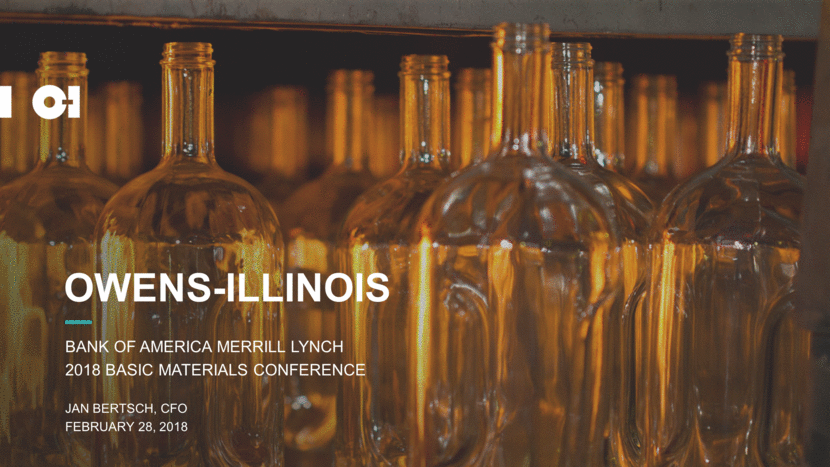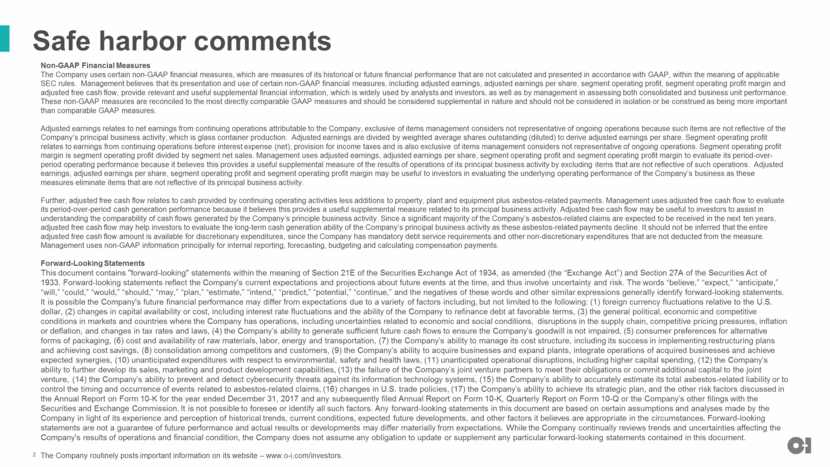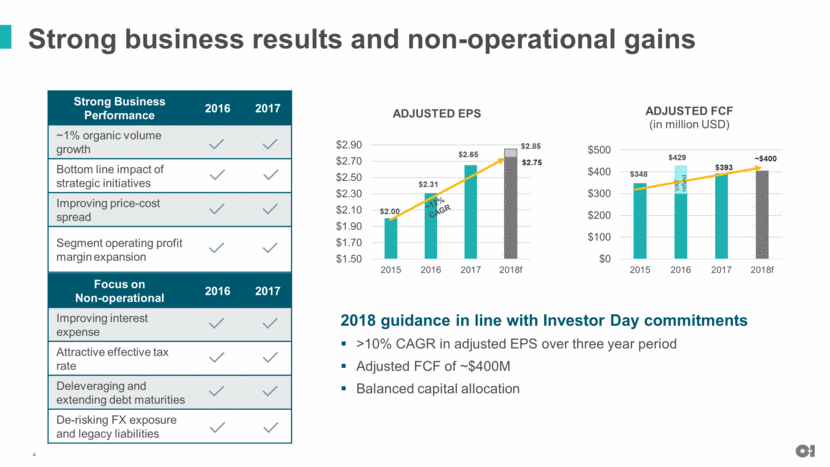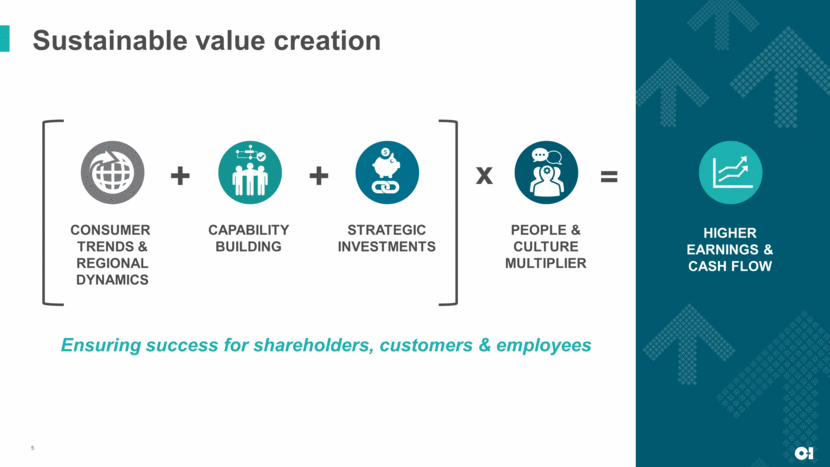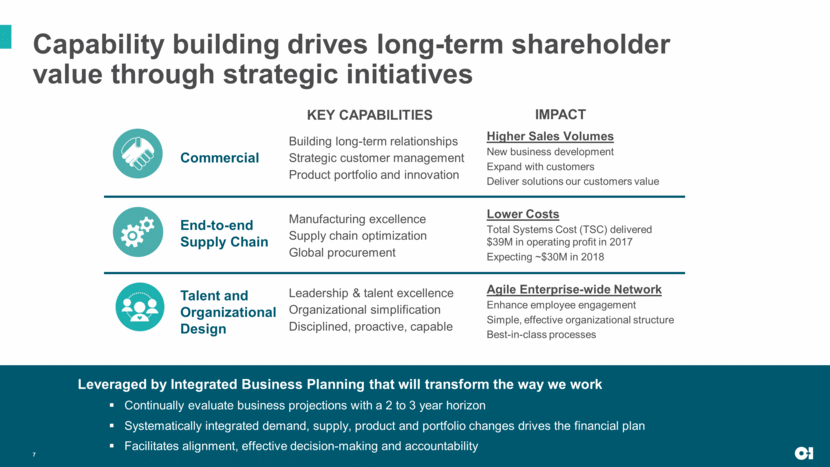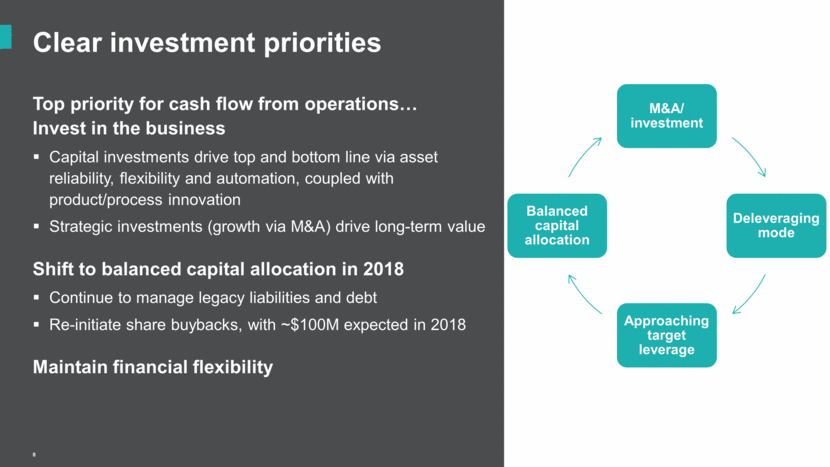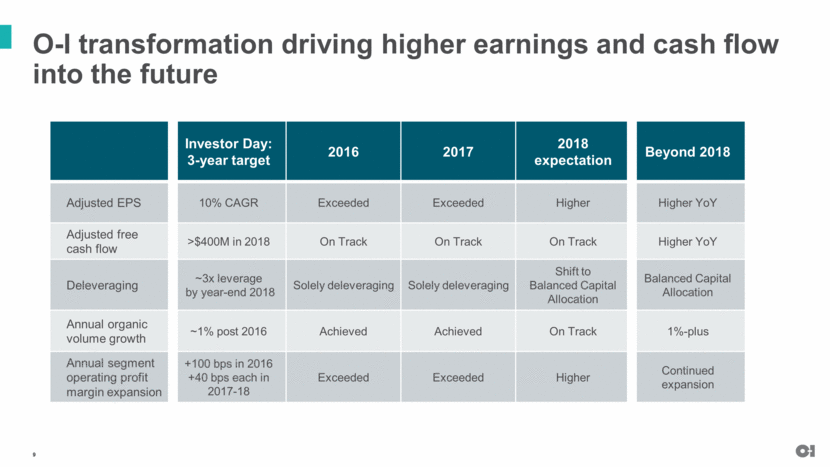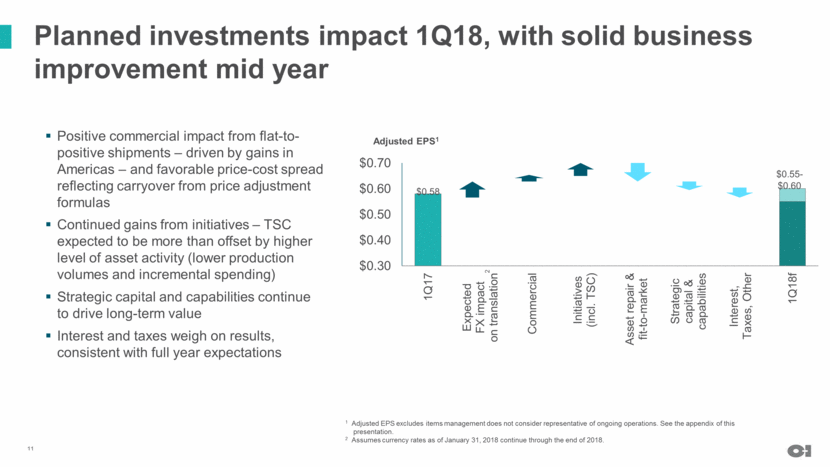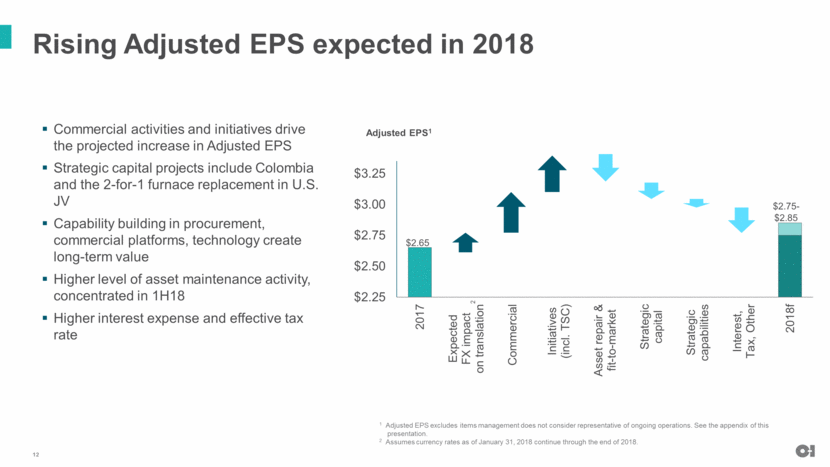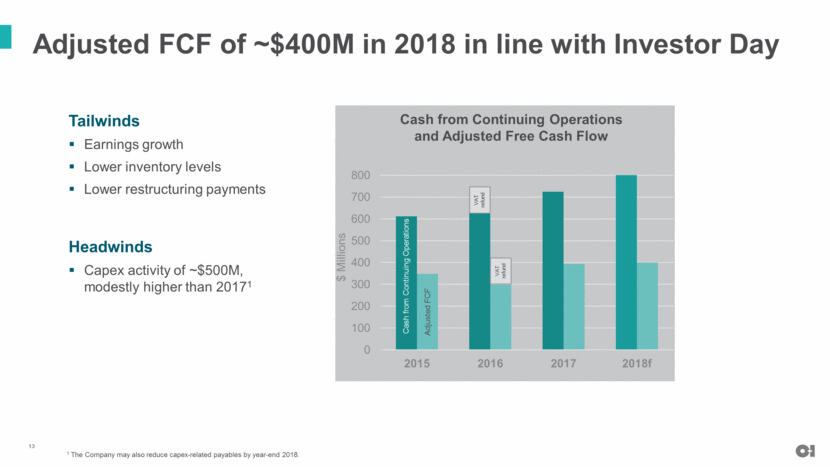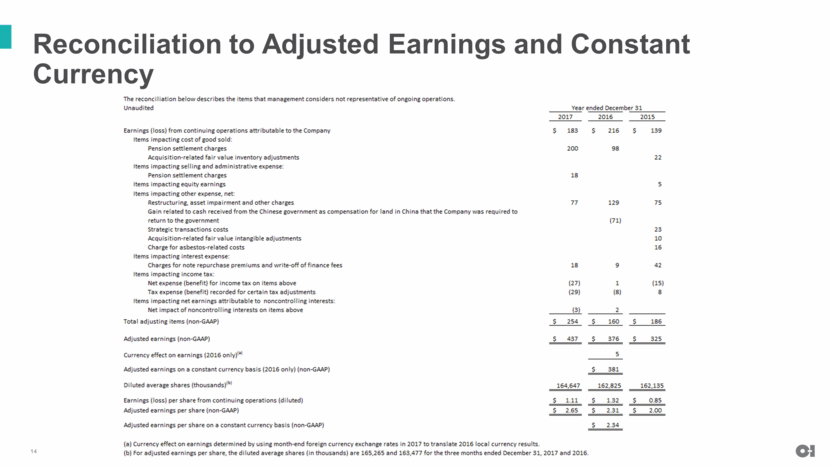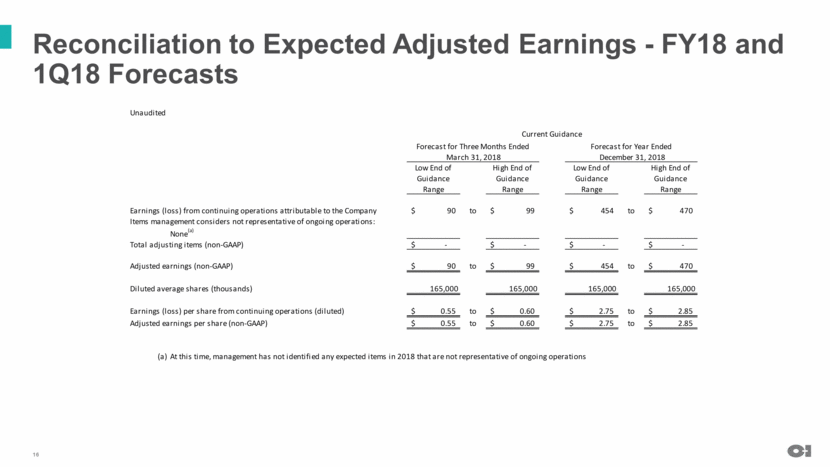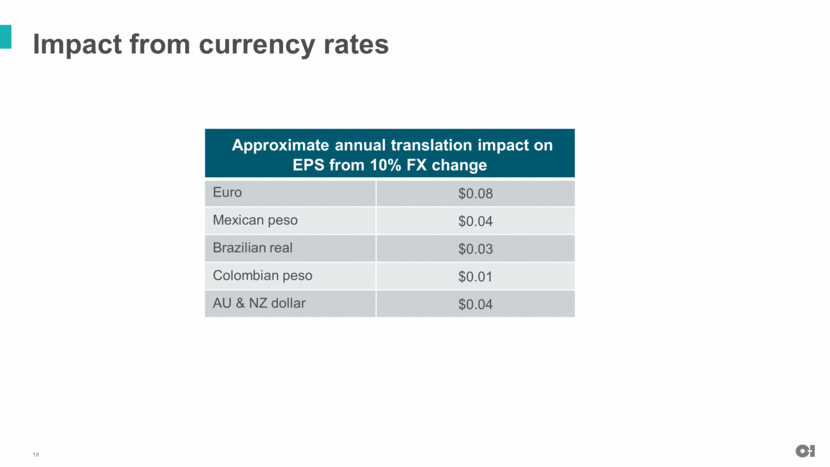Attached files
| file | filename |
|---|---|
| 8-K - 8-K - O-I Glass, Inc. /DE/ | a18-7194_18k.htm |
|
|
Bank of America Merrill lynch 2018 basic materials conference Jan Bertsch, CFO February 28, 2018 Owens-Illinois |
|
|
Safe harbor comments Non-GAAP Financial Measures The Company uses certain non-GAAP financial measures, which are measures of its historical or future financial performance that are not calculated and presented in accordance with GAAP, within the meaning of applicable SEC rules. Management believes that its presentation and use of certain non-GAAP financial measures, including adjusted earnings, adjusted earnings per share, segment operating profit, segment operating profit margin and adjusted free cash flow, provide relevant and useful supplemental financial information, which is widely used by analysts and investors, as well as by management in assessing both consolidated and business unit performance. These non-GAAP measures are reconciled to the most directly comparable GAAP measures and should be considered supplemental in nature and should not be considered in isolation or be construed as being more important than comparable GAAP measures. Adjusted earnings relates to net earnings from continuing operations attributable to the Company, exclusive of items management considers not representative of ongoing operations because such items are not reflective of the Company’s principal business activity, which is glass container production. Adjusted earnings are divided by weighted average shares outstanding (diluted) to derive adjusted earnings per share. Segment operating profit relates to earnings from continuing operations before interest expense (net), provision for income taxes and is also exclusive of items management considers not representative of ongoing operations. Segment operating profit margin is segment operating profit divided by segment net sales. Management uses adjusted earnings, adjusted earnings per share, segment operating profit and segment operating profit margin to evaluate its period-over-period operating performance because it believes this provides a useful supplemental measure of the results of operations of its principal business activity by excluding items that are not reflective of such operations. Adjusted earnings, adjusted earnings per share, segment operating profit and segment operating profit margin may be useful to investors in evaluating the underlying operating performance of the Company’s business as these measures eliminate items that are not reflective of its principal business activity. Further, adjusted free cash flow relates to cash provided by continuing operating activities less additions to property, plant and equipment plus asbestos-related payments. Management uses adjusted free cash flow to evaluate its period-over-period cash generation performance because it believes this provides a useful supplemental measure related to its principal business activity. Adjusted free cash flow may be useful to investors to assist in understanding the comparability of cash flows generated by the Company’s principle business activity. Since a significant majority of the Company’s asbestos-related claims are expected to be received in the next ten years, adjusted free cash flow may help investors to evaluate the long-term cash generation ability of the Company’s principal business activity as these asbestos-related payments decline. It should not be inferred that the entire adjusted free cash flow amount is available for discretionary expenditures, since the Company has mandatory debt service requirements and other non-discretionary expenditures that are not deducted from the measure. Management uses non-GAAP information principally for internal reporting, forecasting, budgeting and calculating compensation payments. Forward-Looking Statements This document contains "forward-looking" statements within the meaning of Section 21E of the Securities Exchange Act of 1934, as amended (the “Exchange Act”) and Section 27A of the Securities Act of 1933. Forward-looking statements reflect the Company's current expectations and projections about future events at the time, and thus involve uncertainty and risk. The words “believe,” “expect,” “anticipate,” “will,” “could,” “would,” “should,” “may,” “plan,” “estimate,” “intend,” “predict,” “potential,” “continue,” and the negatives of these words and other similar expressions generally identify forward-looking statements. It is possible the Company's future financial performance may differ from expectations due to a variety of factors including, but not limited to the following: (1) foreign currency fluctuations relative to the U.S. dollar, (2) changes in capital availability or cost, including interest rate fluctuations and the ability of the Company to refinance debt at favorable terms, (3) the general political, economic and competitive conditions in markets and countries where the Company has operations, including uncertainties related to economic and social conditions, disruptions in the supply chain, competitive pricing pressures, inflation or deflation, and changes in tax rates and laws, (4) the Company’s ability to generate sufficient future cash flows to ensure the Company’s goodwill is not impaired, (5) consumer preferences for alternative forms of packaging, (6) cost and availability of raw materials, labor, energy and transportation, (7) the Company’s ability to manage its cost structure, including its success in implementing restructuring plans and achieving cost savings, (8) consolidation among competitors and customers, (9) the Company’s ability to acquire businesses and expand plants, integrate operations of acquired businesses and achieve expected synergies, (10) unanticipated expenditures with respect to environmental, safety and health laws, (11) unanticipated operational disruptions, including higher capital spending, (12) the Company’s ability to further develop its sales, marketing and product development capabilities, (13) the failure of the Company’s joint venture partners to meet their obligations or commit additional capital to the joint venture, (14) the Company’s ability to prevent and detect cybersecurity threats against its information technology systems, (15) the Company’s ability to accurately estimate its total asbestos-related liability or to control the timing and occurrence of events related to asbestos-related claims, (16) changes in U.S. trade policies, (17) the Company’s ability to achieve its strategic plan, and the other risk factors discussed in the Annual Report on Form 10-K for the year ended December 31, 2017 and any subsequently filed Annual Report on Form 10-K, Quarterly Report on Form 10-Q or the Company’s other filings with the Securities and Exchange Commission. It is not possible to foresee or identify all such factors. Any forward-looking statements in this document are based on certain assumptions and analyses made by the Company in light of its experience and perception of historical trends, current conditions, expected future developments, and other factors it believes are appropriate in the circumstances. Forward-looking statements are not a guarantee of future performance and actual results or developments may differ materially from expectations. While the Company continually reviews trends and uncertainties affecting the Company's results of operations and financial condition, the Company does not assume any obligation to update or supplement any particular forward-looking statements contained in this document. The Company routinely posts important information on its website – www.o-i.com/investors. 2 |
|
|
Why invest in O-I? Investment Thesis Leading global franchise in glass containers Well positioned to develop new business and modestly grow organic volumes Secular trends support glass container growth Attractive opportunities in high value segments Evident impact to top and bottom line from investments in capabilities Demonstrable Financial Impact Increasing adjusted EPS1 Generating strong adjusted free cash flow2 Deleveraging and reducing legacy liabilities Investing in O-I stock 1 Adjusted EPS excludes items management does not consider representative of ongoing operations. 2 Adjusted free cash flow is defined as cash provided by continuing operating activities less additions to property, plant and equipment plus asbestos-related payments. 3 |
|
|
4 Strong business results and non-operational gains 2018 guidance in line with Investor Day commitments >10% CAGR in adjusted EPS over three year period Adjusted FCF of ~$400M Balanced capital allocation ~12% CAGR $2.85 $2.75 $393 VAT refund ~$400 Strong Business Performance 2016 2017 ~1% organic volume growth Bottom line impact of strategic initiatives Improving price-cost spread Segment operating profit margin expansion Focus on Non-operational 2016 2017 Improving interest expense Attractive effective tax rate Deleveraging and extending debt maturities De-risking FX exposure and legacy liabilities |
|
|
5 Sustainable value creation CONSUMER TRENDS & REGIONAL DYNAMICS CAPABILITY BUILDING STRATEGIC INVESTMENTS PEOPLE & CULTURE MULTIPLIER x + + = Ensuring success for shareholders, customers & employees HIGHER EARNINGS & CASH FLOW |
|
|
Rising operating profit and margin in 2018 and beyond 6 Continuing, solid end-consumer and regional trends AMERICAS EUROPE Trends Non-beer segments continue to grow Ongoing U.S. mainstream beer trends; strong performance in imports Solid demand growth in Mexico Double-digit growth in Brazil in 1H18 Trends Supply/demand dynamics essentially unchanged Constructive pricing environment for annual contracts ASIA PACIFIC Trends Solid demand growth across region; more pronounced in emerging mkts Addressing structural issues to drive sustainable value-creation Finite, focused investments leads to strong performance in 2H18 and beyond ENTERPRISE 2018 Expectations Annual sales volume growth ~1% Price-cost spread neutral Continued gains from Total Systems Cost Segment operating profit margin expansion >40 bps |
|
|
7 Capability building drives long-term shareholder value through strategic initiatives Leveraged by Integrated Business Planning that will transform the way we work Continually evaluate business projections with a 2 to 3 year horizon Systematically integrated demand, supply, product and portfolio changes drives the financial plan Facilitates alignment, effective decision-making and accountability Commercial End-to-end Supply Chain Talent and Organizational Design Building long-term relationships Strategic customer management Product portfolio and innovation Manufacturing excellence Supply chain optimization Global procurement Leadership & talent excellence Organizational simplification Disciplined, proactive, capable Higher Sales Volumes New business development Expand with customers Deliver solutions our customers value Lower Costs Total Systems Cost (TSC) delivered $39M in operating profit in 2017 Expecting ~$30M in 2018 Agile Enterprise-wide Network Enhance employee engagement Simple, effective organizational structure Best-in-class processes KEY CAPABILITIES IMPACT |
|
|
Clear investment priorities 8 Top priority for cash flow from operations Invest in the business Capital investments drive top and bottom line via asset reliability, flexibility and automation, coupled with product/process innovation Strategic investments (growth via M&A) drive long-term value Shift to balanced capital allocation in 2018 Continue to manage legacy liabilities and debt Re-initiate share buybacks, with ~$100M expected in 2018 Maintain financial flexibility M&A/ investment Deleveraging mode Approaching target leverage Balanced capital allocation |
|
|
9 O-I transformation driving higher earnings and cash flow into the future Investor Day: 3-year target 2016 2017 2018 expectation Beyond 2018 Adjusted EPS 10% CAGR Exceeded Exceeded Higher Higher YoY Adjusted free cash flow >$400M in 2018 On Track On Track On Track Higher YoY Deleveraging ~3x leverage by year-end 2018 Solely deleveraging Solely deleveraging Shift to Balanced Capital Allocation Balanced Capital Allocation Annual organic volume growth ~1% post 2016 Achieved Achieved On Track 1%-plus Annual segment operating profit margin expansion +100 bps in 2016 +40 bps each in 2017-18 Exceeded Exceeded Higher Continued expansion |
|
|
Appendix |
|
|
Planned investments impact 1Q18, with solid business improvement mid year 11 1 Adjusted EPS excludes items management does not consider representative of ongoing operations. See the appendix of this presentation. 2 Assumes currency rates as of January 31, 2018 continue through the end of 2018. Positive commercial impact from flat-to-positive shipments – driven by gains in Americas – and favorable price-cost spread reflecting carryover from price adjustment formulas Continued gains from initiatives – TSC expected to be more than offset by higher level of asset activity (lower production volumes and incremental spending) Strategic capital and capabilities continue to drive long-term value Interest and taxes weigh on results, consistent with full year expectations $0.55-$0.60 Adjusted EPS1 2 $0.58 |
|
|
12 Rising Adjusted EPS expected in 2018 1 Adjusted EPS excludes items management does not consider representative of ongoing operations. See the appendix of this presentation. 2 Assumes currency rates as of January 31, 2018 continue through the end of 2018. Commercial activities and initiatives drive the projected increase in Adjusted EPS Strategic capital projects include Colombia and the 2-for-1 furnace replacement in U.S. JV Capability building in procurement, commercial platforms, technology create long-term value Higher level of asset maintenance activity, concentrated in 1H18 Higher interest expense and effective tax rate $2.75-$2.85 Adjusted EPS1 2 $2.65 |
|
|
13 Adjusted FCF of ~$400M in 2018 in line with Investor Day Tailwinds Earnings growth Lower inventory levels Lower restructuring payments Headwinds Capex activity of ~$500M, modestly higher than 20171 1 The Company may also reduce capex-related payables by year-end 2018. VAT refund Cash from Continuing Operations and Adjusted Free Cash Flow Adjusted FCF Cash from Continuing Operations VAT refund |
|
|
Reconciliation to Adjusted Earnings and Constant Currency 14 |
|
|
15 Reconciliation to Adjusted Earnings and Constant Currency – 1Q 2017 The reconciliation below describes the items that management considers not representative of ongoing operations. Unaudited Three months ended March 31 2017 49 $ Items impacting other expense, net: Restructuring, asset impairment and other charges 39 Items impacting interest expense: Charges for note repurchase premiums and write-off of finance fees 17 Items impacting income tax: Net expense (benefit) for income tax on items above (9) Net impact of noncontrolling interests on items above (1) Total adjusting items (non-GAAP) 46 $ Adjusted earnings (non-GAAP) 95 $ Diluted average shares (thousands) 163,840 Earnings (loss) per share from continuing operations (diluted) 0.30 $ Adjusted earnings per share (non-GAAP) 0.58 $ Earnings (loss) from continuing operations attributable to the Company Items impacting net earnings attributable to noncontrolling interests: (Dollars in millions, except per share amounts) |
|
|
16 Reconciliation to Expected Adjusted Earnings - FY18 and 1Q18 Forecasts Unaudited Low End of Guidance Range High End of Guidance Range Low End of Guidance Range High End of Guidance Range 90 $ to 99 $ 454 $ to 470 $ Items management considers not representative of ongoing operations: None (a) Total adjusting items (non-GAAP) - $ - $ - $ - $ Adjusted earnings (non-GAAP) 90 $ to 99 $ 454 $ to 470 $ 165,000 165,000 165,000 165,000 Earnings (loss) per share from continuing operations (diluted) 0.55 $ to 0.60 $ 2.75 $ to 2.85 $ Adjusted earnings per share (non-GAAP) 0.55 $ to 0.60 $ 2.75 $ to 2.85 $ (a) Diluted average shares (thousands) Forecast for Three Months Ended March 31, 2018 Earnings (loss) from continuing operations attributable to the Company Forecast for Year Ended December 31, 2018 Current Guidance At this time, management has not identified any expected items in 2018 that are not representative of ongoing operations |
|
|
Reconciliation to Adjusted Free Cash Flow Note: Management defines adjusted free cash flow as cash provided by continuing operating activities less additions to property, plant and equipment plus asbestos-related payments (all components as determined in accordance with GAAP). 17 $ Millions Unaudited 2018 2015 2016 2017 Estimate Cash provided by continuing operating activities $ 612 $ 758 $ 724 ~ $ 800 Deduct: Cash payments for property, plant and equipment (402) (454) (441) ~ (500) Add: Asbestos-related payments 138 125 110 ~ 100 Adjusted free cash flow (non-GAAP) $ 348 $ 429 $ 393 ~ $ 400 Cash utilized in investing activities $ (2,748) $ (417) $ (351) (a) Cash provided by (utilized in) financing activities $ 2,057 $ (228) $ (392) (a) (a) Forecasted amounts are not yet determinable at this time. |
|
|
Impact from currency rates Approximate annual translation impact on EPS from 10% FX change Euro $0.08 Mexican peso $0.04 Brazilian real $0.03 Colombian peso $0.01 AU & NZ dollar $0.04 18 |

